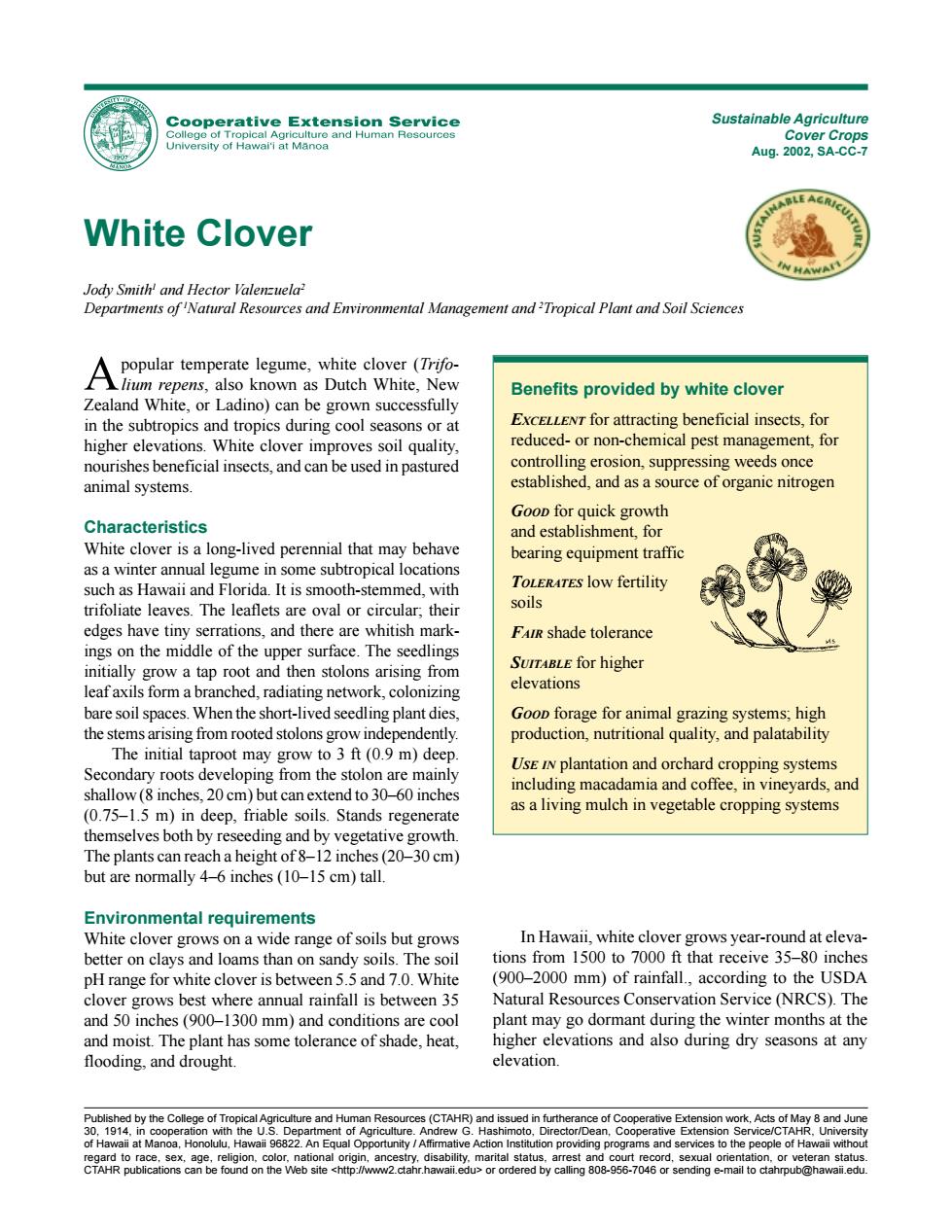正在加载图片...

Sustainable agriculture White Clover and envin t and"Tropical Plant and Soil Sciences popular temperate egume, Benefits provided by white clover no)ca e grown successfully ExCELLENT for attracting beneficial insects,for a te clover improves soil quality reduced-or non-chemical pest management,for icial insects,and can be used in pasture controlling erosion,suppressing weeds once established,and as a source of organic nitrogen Characteristics Goop for quick growth and establishment,for White clo isa long-lived per ennial that may behay bearing equipment traffic as a winter annual legume in ical location such as Hawaii and Florida it is ooth-stemmed with ToLERATES low fertility trifoliate leaves The leaflets are val or cireular thei soils edges have tiny serrations and there are whitish mark. F shade tolerance ings on the middle of the upper surface.The seedlings initially grow a tap root and then stolons arising from SUITABLE for higher leaf axils form a branched,radiating network,colonizing elevations bare soil spaces.When the short-lived seedling plant dies Goop forage for animal grazing systems;high the stems arising from rooted stolons grow independently production,nutritional quality,and palatability The initial taproot may grow to 3 ft(09 m)deer Secondary roots developing from the stolon are mainly UsE IN plantation and orchard cropping systems shallow(8 inches,20 cm)but can extend to 30-60 inches including macadamia and coffee,in vineyards,and (0.75-1.5 m)in deep,friable soils.Stands regenerate as a living mulch in vegetable cropping systems themselves both by reseeding and by vegetative growth The plants can reach a height of8- -12 inche (20-30cm) but are normally 4-6 inches (10-15 cm)tal Environmental requir ents te cl r gr s on a wide range e of so In Hawaii,white clove nd 1500to7000t n on sar H range for ver is b en Whit (900-2000 m)of o the USDA all is b Natural r ORCS)The ant d nths at the flooding andd ant has some tol elevation. dby the College ofTrop and Hu s(CTAHR operative Extension w 822 An Foual ution providing pr ms and services to the peopeofH try,disability,ma ng Benefits provided by white clover EXCELLENT for attracting beneficial insects, for reduced- or non-chemical pest management, for controlling erosion, suppressing weeds once established, and as a source of organic nitrogen GOOD for quick growth and establishment, for bearing equipment traffic TOLERATES low fertility soils FAIR shade tolerance SUITABLE for higher elevations GOOD forage for animal grazing systems; high production, nutritional quality, and palatability USE IN plantation and orchard cropping systems including macadamia and coffee, in vineyards, and as a living mulch in vegetable cropping systems Published by the College of Tropical Agriculture and Human Resources (CTAHR) and issued in furtherance of Cooperative Extension work, Acts of May 8 and June 30, 1914, in cooperation with the U.S. Department of Agriculture. Andrew G. Hashimoto, Director/Dean, Cooperative Extension Service/CTAHR, University of Hawaii at Manoa, Honolulu, Hawaii 96822. An Equal Opportunity / Affirmative Action Institution providing programs and services to the people of Hawaii without regard to race, sex, age, religion, color, national origin, ancestry, disability, marital status, arrest and court record, sexual orientation, or veteran status. CTAHR publications can be found on the Web site <http://www2.ctahr.hawaii.edu> or ordered by calling 808-956-7046 or sending e-mail to ctahrpub@hawaii.edu. White Clover Jody Smith1 and Hector Valenzuela2 Departments of 1 Natural Resources and Environmental Management and 2 Tropical Plant and Soil Sciences Apopular temperate legume, white clover (Trifolium repens, also known as Dutch White, New Zealand White, or Ladino) can be grown successfully in the subtropics and tropics during cool seasons or at higher elevations. White clover improves soil quality, nourishes beneficial insects, and can be used in pastured animal systems. Characteristics White clover is a long-lived perennial that may behave as a winter annual legume in some subtropical locations such as Hawaii and Florida. It is smooth-stemmed, with trifoliate leaves. The leaflets are oval or circular; their edges have tiny serrations, and there are whitish markings on the middle of the upper surface. The seedlings initially grow a tap root and then stolons arising from leaf axils form a branched, radiating network, colonizing bare soil spaces. When the short-lived seedling plant dies, the stems arising from rooted stolons grow independently. The initial taproot may grow to 3 ft (0.9 m) deep. Secondary roots developing from the stolon are mainly shallow (8 inches, 20 cm) but can extend to 30–60 inches (0.75–1.5 m) in deep, friable soils. Stands regenerate themselves both by reseeding and by vegetative growth. The plants can reach a height of 8–12 inches (20–30 cm) but are normally 4–6 inches (10–15 cm) tall. Environmental requirements White clover grows on a wide range of soils but grows better on clays and loams than on sandy soils. The soil pH range for white clover is between 5.5 and 7.0. White clover grows best where annual rainfall is between 35 and 50 inches (900–1300 mm) and conditions are cool and moist. The plant has some tolerance of shade, heat, flooding, and drought. In Hawaii, white clover grows year-round at elevations from 1500 to 7000 ft that receive 35–80 inches (900–2000 mm) of rainfall., according to the USDA Natural Resources Conservation Service (NRCS). The plant may go dormant during the winter months at the higher elevations and also during dry seasons at any elevation. Sustainable Agriculture Cover Crops Aug. 2002, SA-CC-7